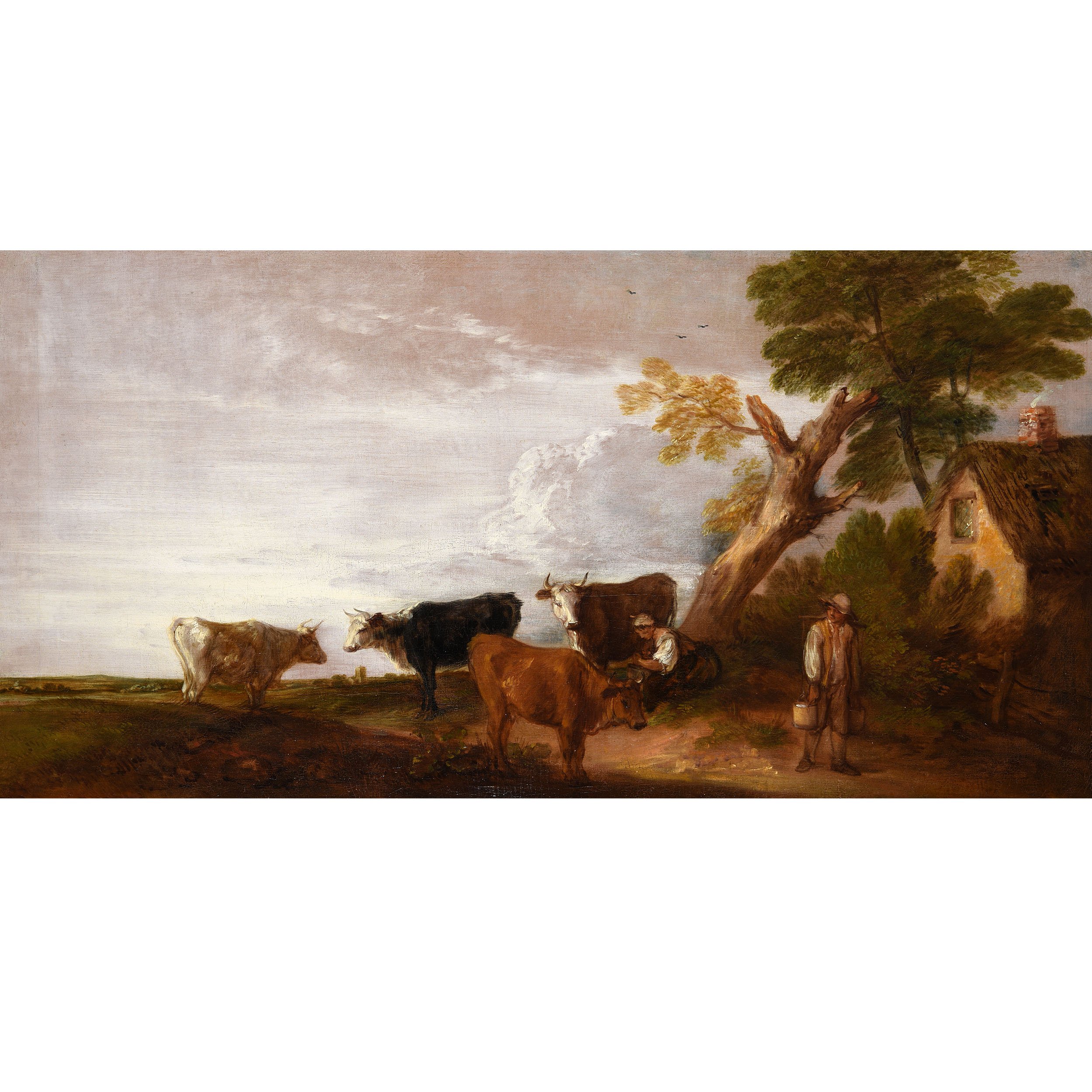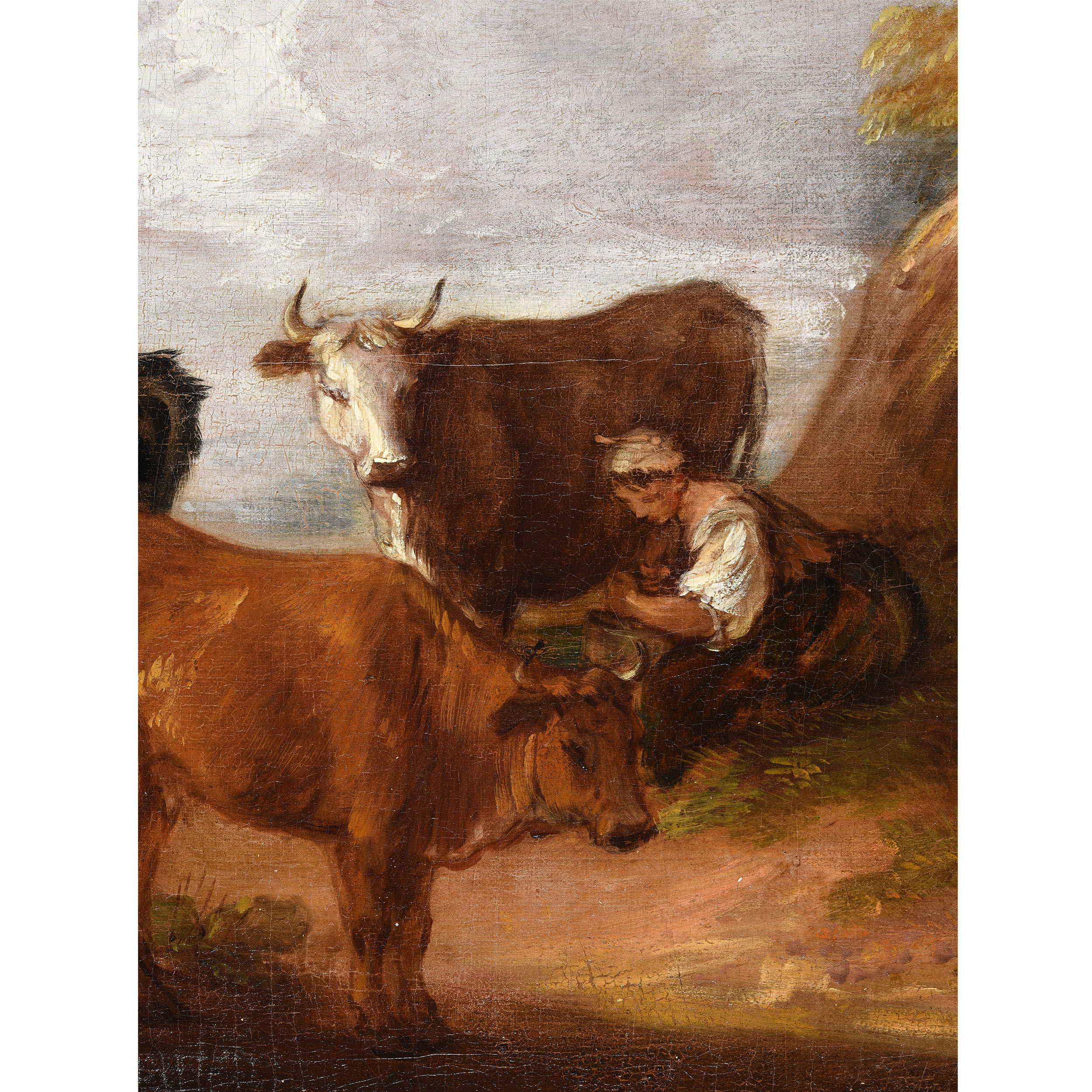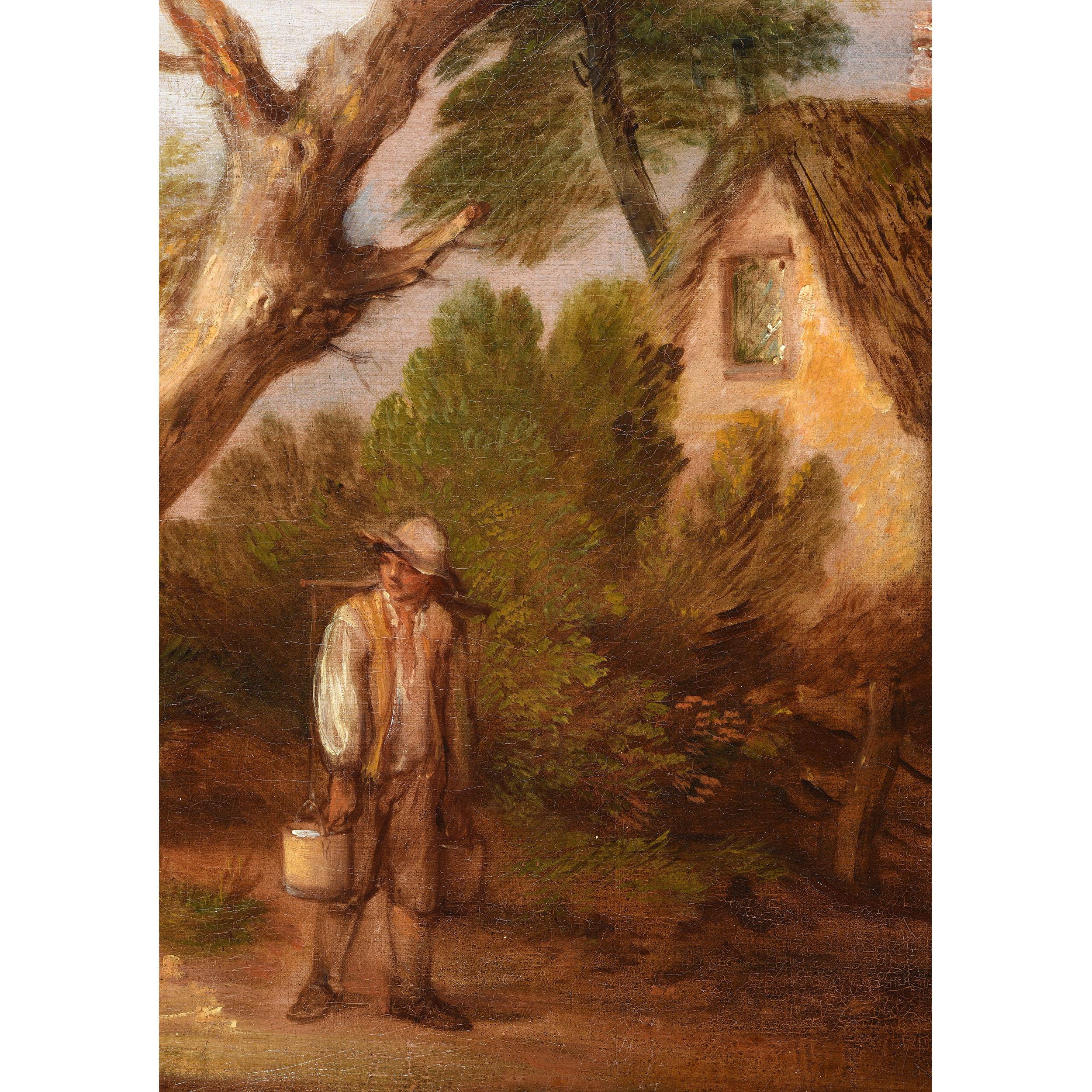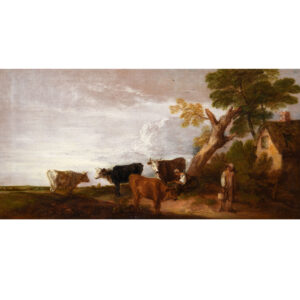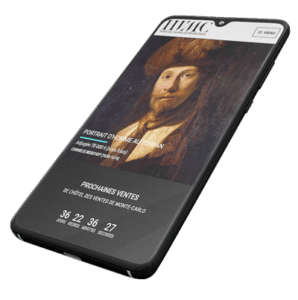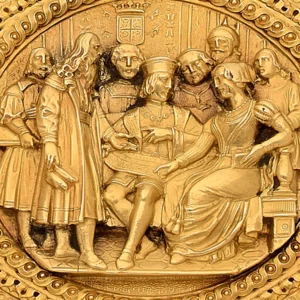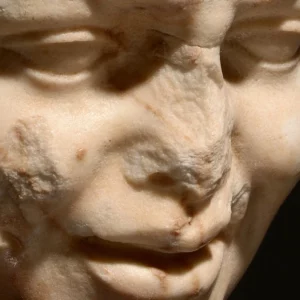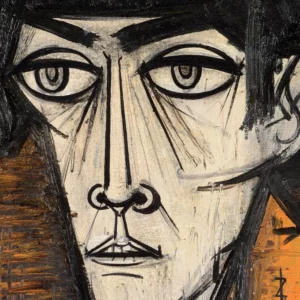Paysage avec paysan, laitière et vaches devant une maison
de campagne
Toile
56 x 110 cm
Provenance : Lawrie, 1898 ; acquis de celui-ci par R.W.Hudson, 1902 ; resté dans sa descendance,
Collection particulière, Monte-Carlo
Villa Paloma : -Inventaire 1950 ; -Inventaire 1934
Exposition :
Corporation of London Art Gallery, Selection of Works by French and English Painters of the Eighteenth Century, 1902, no. 52
Bibliographie:
-Sir Walter Armstrong, Gainsborough and his place in English Art, 1898 p.206, illustré. P.VII
-A.B. Chamberlain, Thomas Gainsborough, 1903, pages.144-145, illustré.p.51;
-Sir Walter Armstrong, Gainsborough, 1904, p.287, illustré p.16;
-William Boulton, Thomas Gainsborough his Life, Works, Friends and Sitters, 1905, pages 48,62;
-E.K. Waterhouse, Thomas Gainsborough, 1953, no 905;
-John Hayes, The Landscape Paintigs of Thomas Gainsborough, Londres, 1982, vol. 2, p. 457, n°111 (repr.p.458).
Hayes date ce tableau vers 1772-1774, c’est-à-dire à la fin du séjour de Gainsborough à Bath (1759-1774) et juste avant sa seconde installation à Londres. C’est à cette époque qu’il peint certains de ses plus beaux paysage purs (Philadelphia Museum of Art ; Iveagh Bequest - Kenwood, Londres ; Tate Gallery, Londres ; Cincinnati Art
Museum ; Yale center for British Art, New Haven).
Gainsborough montre un vrai plaisir à peindre des paysages, que ce soit au second plan de ses portraits, qui lui ont amené la notoriété et la richesse, mais aussi en tant que genre indépendant. Il est l’un des premiers peintres autochtones de paysages de la campagne anglaise. Dès ses premières années à Londres en 1740, il semble avoir été reconnu comme dans ce domaine, notamment grâce à des vues de son Suffolck natal. En 1748, son talent était déjà suffisamment remarqué pour que William Hogarth lui commande une petite vue de la Chartreuse du Foundling Hospital (Thomas Coram Foundation). Ses descriptions ne sont pas strictement topographiques, mais plutôt une
interprétation poétique des lieux avec le souvenir des peintres hollandais du 17ème siècle, en particulier Jacob van Ruisdael, Jan Wijnants dans sa jeunesse. Ensuite, il pose un regard sur les œuvres d’Albert Cuyp (sensible ici dans la façon de grouper les quatre vaches ou dans le détail de la bergère en train de traire), de Téniers, et de
Claude Lorrain.
L’influence du réalisme hollandais laisse place, dans les années suivantes, à celle plus dramatique et imaginative des paysages de Peter Paul Rubens, à travers une palette légère et une touche plus libre, enlevée, un cheminement stylistique qui rappelle celui de Fragonard paysagiste ,quelques années plus tard.
Mais la manière est ici tout à fait celle du 18e siècle, « rocaille », plus esquissée, avec une composition dynamique partagée par une diagonale ascendante: à droite un grand ciel argenté, tout en vibrations
lumineuses, alors que les animaux, les deux figures et la maison (cottage) sont concentrés en bas et sur le côté gauche. La subtilité et l’intelligence de Gainsborough font que cet oblique n’est pas strict, légèrement décalé par le tronc d’arbre, et rompu à la fois par la pente descendante du toit de chaume et la verticalité du garçon qui porte les
seaux de lait.
Eric Turquin nous présente une œuvre de :
THOMAS GAINSBOROUGH (1727-1788)
PAYSAGE AVEC PAYSAN LAITIÈRE ET VACHES DEVANT UNE MAISON DE CAMPAGNE
Cette pièce sera mise en vente le dimanche 8 mai à l 'Hôtel des Ventes .
Landscape with farmer, milkmaid, and cows before a Country home
Canvas
56 x 110 cm
Provenance: Lawrie, 1898; acquired by the latter from R.W. Hudson,
1902; through descent, private collection, Monte-Carlo
Exhibit:
Corporation of London Art Gallery, Selection of Works by French and
English Painters of the Eighteenth Century, 1902, no. 5
Bibliography:
-Sir Walter Armstrong, Gainsborough and his place in English Art, 1898 p.206, illustrated. P.VII
-A.B. Chamberlain, Thomas Gainsborough, 1903, pages.144-145, illustrated.p.51;
-Sir Walter Armstrong, Gainsborough, 1904, p.287, illustrated p.16;
-William Boulton, Thomas Gainsborough his Life, Works,
Friends and Sitters, 1905, pages 48,62;
-E.K. Waterhouse, Thomas Gainsborough, 1953, no. 905;
-John Hayes, The Landscape Paintings of Thomas Gainsborough, London, 1982, vol. 2, p. 457, No.111 (repr.p.458).
Hayes dates this painting to circa 1772-1774, at the end of Gainsborough’s sojourn in Bath (1759-1774) right before his second stint in London. This period would give rise to some of Gainsborough’s finest, most untouched landscapes (Philadelphia Museum of Art; Iveagh Bequest – Kenwood, London; Tate Gallery, London; Cincinnati Art Museum; Yale Center for British Art, New Haven).
Gainsborough gained great satisfaction from landscape painting. This applies to both background landscapes in his portraits, which cemented his reputation and wealth, and pure landscapes. Indeed, Gainsborough is one of the first native painters of English countryside landscapes. During a first spell in the English capital from 1740, he was seemingly conferred a special status as a landscape painter, particularly through drawings of his homeland, Suffolk. Then, in 1748, Gainsborough’s talent was amply recognised by a certain William Hogarth who commissioned him to paint the Charterhouse of the Foundling Hospital (Thomas Coram Foundation). His portraits do not necessarily spotlight the topography.
Rather, they illustrate a poetic sensibility in the depiction of scenes with a nod to seventeenth century Dutch painters, Jacob van Ruisdael and Jan Wijnants through his earlier works. Gainsborough also offers perspective on the works of Albert Cuyp, Teniers, and Claude Lorrain, with the striking group positioning of the four cows coupled with the focus on the shepherdess milking them.
The subsequent period would see the Dutch realism influence be compromised for the more dramatic and imaginative style of Peter Paul Rubens. With a lighter palette and a freer, more spirited touch, this technique resembles that of landscape painter – Jean-Honoré Fragonard – some years later.
The work in question is a faithful representation of eighteenth century ‘Rococo’ style. The painting has a more decorative finish with its dynamic composition split by an upward diagonal. To the right of the canvas, a sweeping,silvery sky punctuated by stirrings of light juxtaposed with animals, two figures, and a cottage positioned in the background to the left. Gainsborough’s nuanced and intelligent approach to his art is reflected in the diagonal.
The latter is slightly staggered by the tree trunk whilst also being subverted by the thatched roof and the boy stood upright carrying milk buckets
Description complète


